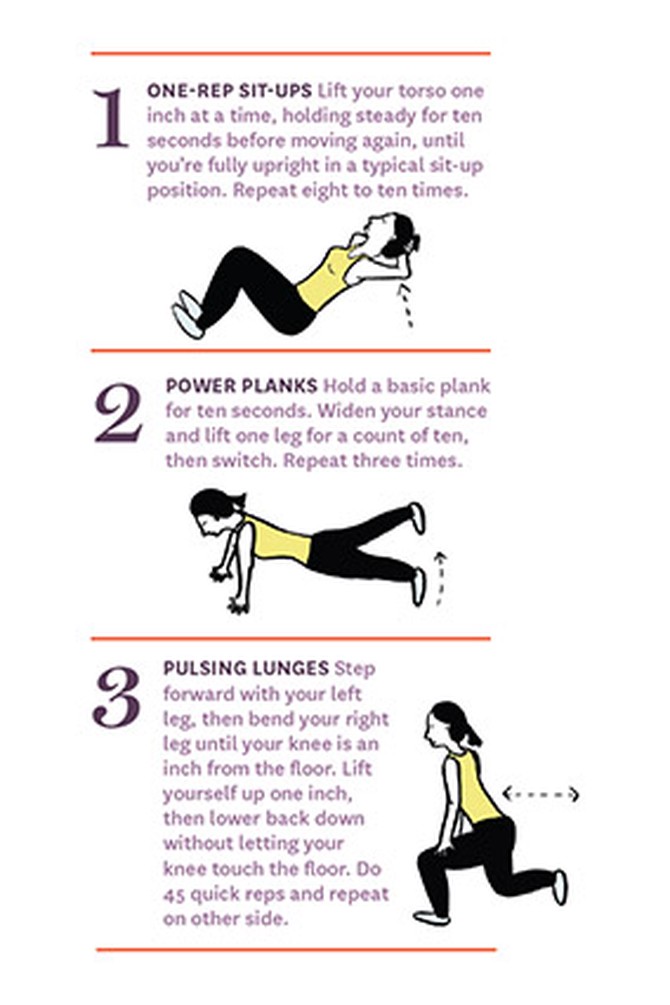Dr. Oz's Guide to Getting Healthy in Your 30s
This decade it's all about keeping your metabolism humming.
By Dr. Mehmet Oz

Illustration: Joel Holland
Eat This: Grab a Better Bite
To keep your metabolism in gear, you need to combine exercise with simple dietary changes. For starters, eat 200 fewer total calories a day than you did in your 20s. (That means 1,800 to 2,200 calories, depending on how active you are.) Make sure your diet includes metabolism-boosting foods like peppers; research subjects who took a supplement with a compound like the one that gives chilies their spice burned about 100 extra calories a day. And don't forget to load up on protein (a minimum of 46 grams daily), which requires at least twice as many calories to digest as carbs. Try this tuna-vegetable wrap for a protein-packed meal with a kick.

Photo: Thinkstock
Test This: Follow Your Heart
With the risk of developing heart disease increasing in your 40s, now's the time to undergo a basic cardiac exam. Your doctor will note any irregular heart or breath sounds, then test your blood pressure, pulse, "good" (HDL) and "bad" (LDL) cholesterol, and triglycerides; your current readings will serve as a baseline for future results. Keep your levels in check until you're 50, and chances are good you'll steer clear of heart disease for the rest of your life.

Illustration: Joel Holland
Do This: Get Strong
Muscle burns three times as many calories as fat. After age 30, though, most people will see up to 8 percent of their muscle mass diminish each decade, a loss that really puts the brakes on metabolism. But just two 30-minute strength-training sessions a week can firm you up and counteract that slowdown. Start with basic moves like sit-ups, planks, and lunges, then up your intensity with these variations:
1. One-Rep Sit-Ups
Lift your torso one inch at a time, holding steady for ten seconds before moving again, until you're fully upright in a typical sit-up position. Repeat eight to ten times.
2. Power Planks
Hold a basic plank for ten seconds. Widen your stance and lift one leg for a count of ten, then switch. Repeat three times.
3. Pulsing Lunges
Step forward with your left leg, then bend your right leg until your knee is an inch from the floor. Lift yourself up one inch, then lower back down without letting your knee touch the floor. Do 45 quick reps and repeat on other side.
Courtesy of Pete Cerqua, author of High Intensity Fitness Revolution for Women (Skyhorse).
1. One-Rep Sit-Ups
Lift your torso one inch at a time, holding steady for ten seconds before moving again, until you're fully upright in a typical sit-up position. Repeat eight to ten times.
2. Power Planks
Hold a basic plank for ten seconds. Widen your stance and lift one leg for a count of ten, then switch. Repeat three times.
3. Pulsing Lunges
Step forward with your left leg, then bend your right leg until your knee is an inch from the floor. Lift yourself up one inch, then lower back down without letting your knee touch the floor. Do 45 quick reps and repeat on other side.
Courtesy of Pete Cerqua, author of High Intensity Fitness Revolution for Women (Skyhorse).

Photo: Levi Brown
Avoid This: Skimping on Sleep
Insufficient rest has been implicated as a risk factor for obesity, stroke, and more aggressive breast cancers later in life. Get in the habit of going to bed at the same time every night (setting a bedtime alarm can help), and follow these tips to wake up refreshed.
How to Drift Off: Get your body ready for sleep with progressive muscle relaxation. While lying on your back, tense your face muscles for five seconds, then relax for 30 seconds. Repeat the exercise for the major muscles of your body, slowly working from your shoulders and neck to the tips of your toes.
How to Go Back to Sleep: Keep a journal by your bed. If you wake up in the middle of the night worried you'll forget something on your never-ending to-do list, jot down a reminder to yourself and sleep a little easier.
How to Wake Up Well: Skip the snooze button. The extra time may feel good, but it's not really helping you. To experience the restorative effects of sleep, your body needs to go through several sleep stages—which won't happen in nine minutes. Instead, set your alarm for later and get more uninterrupted z's.
Next: Dr. Oz's 24 smart strategies for feeling great at every age
How to Drift Off: Get your body ready for sleep with progressive muscle relaxation. While lying on your back, tense your face muscles for five seconds, then relax for 30 seconds. Repeat the exercise for the major muscles of your body, slowly working from your shoulders and neck to the tips of your toes.
How to Go Back to Sleep: Keep a journal by your bed. If you wake up in the middle of the night worried you'll forget something on your never-ending to-do list, jot down a reminder to yourself and sleep a little easier.
How to Wake Up Well: Skip the snooze button. The extra time may feel good, but it's not really helping you. To experience the restorative effects of sleep, your body needs to go through several sleep stages—which won't happen in nine minutes. Instead, set your alarm for later and get more uninterrupted z's.
Next: Dr. Oz's 24 smart strategies for feeling great at every age
From the January 2013 issue of O, The Oprah Magazine
As a reminder, always consult your doctor for medical advice and treatment before starting any program.

